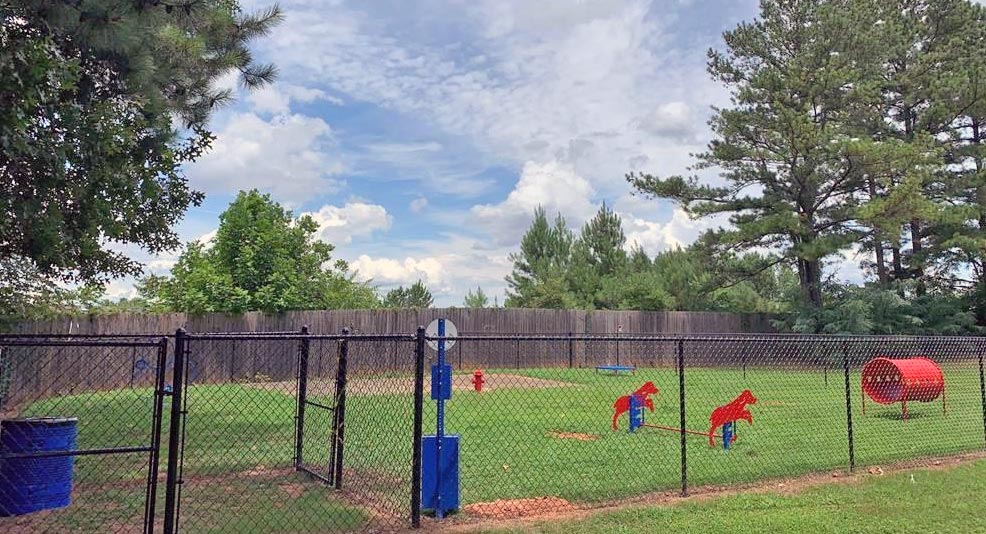Blog
10 Tips for Planning Your Dog Park

You’ve noticed that your community needs a Dog Park, or ‘Bark Park’ as we like to call it. Dog parks have become an expected amenity for newly built residential communities, but older neighborhoods may not have one, or what they do have may need a major re-do. Like us, dogs need to get out and walk/run, play, and socialize with other dogs and people to maintain a healthy life. For some breeds and even some dog owners, walking the neighborhood may not be enough or physically possible. Having a safe, comfortable, and fun space to take your dog where they can play and socialize safely is a great way to promote a fun time together for you and your dog to enjoy the outdoors.
Planning a dog park requires careful consideration of various factors to create a safe and enjoyable space for both dogs and their owners. At Southeast Outdoors Solutions, we can help with everything from planning, building, services, and equipment. There are many factors to consider, here are some tips to get you started!
Determine the Park’s Purpose
Decide what the primary focus of your dog park will be. Will it be a socialization area, an exercise space, or a combination of both? This will influence the park’s design and amenities.
Select an Appropriate Location
Consider proximity to residential areas, you’ll want your dog park to be easily accessible to dog owners, and choosing a location within an established neighborhood increases the potential for daily visitors. It’s important to remember to consider any noise restrictions and the availability of utilities.
Establish Park Rules & Guidelines
Clearly define the rules and expectations for dog owners using the park. Cover topics such as leash requirements, vaccination guidelines, waste disposal, and dog (and their owner’s) behavior expectations.
Designate Separate Areas
Create distinct sections within the park for different dog sizes or temperaments. This allows small and large dogs to play separately, ensuring the safety and comfort of all dogs. And, don’t forget about older and or physically challenged dogs and owners. Consider ways to incorporate easy access to and within your park for dogs or owners with wheelchairs or who may need safe, shaded, comfortable places to sit. Older generations, both dog and owner alike, like to get out and socialize too.
Provide Adequate Fencing
Installing sturdy fencing is not optional, it’s a must. Make sure that the fence covers the entire length of your park and its amenities, using materials that are durable, dog-proof, and tall enough to discourage jumping. This not only protects the dogs that visit your park but their owners and any liability for you as well. No one wants a dog to escape or get hurt because the fencing wasn’t built sturdy enough.
Incorporate Shade & Water Sources
While this tip may seem obvious, too many cities and builders plant only small trees and bushes. Yes, they will grow, eventually, but most likely not in time to provide proper shade when you first open your dog park or during the warmer months. While many dog owners come prepared, it’s still essential to have dog-friendly water stations throughout your park. Providing these simple amenities allows for all visitors to enjoy a comfortable experience, will continue to draw more people and their dogs, and will help them want to return and stay longer.
Include Agility & Play Equipment
This can be simple things such as tunnels, ramps, and jumps. Even smaller dogs will benefit from play structures like climbing structures and the like. Adding equipment provides dogs with mental stimulation and physical exercise, and gives the dog who are more shy something to explore and maybe even make a new friend.
Use Dog-Friendly Landscaping
Another very important part of building your dog park is landscaping. Dogs of all ages, sizes, and breeds are foundationally curious and rely on their sense of smell and taste to learn. This leaves a high probability that some will sample the grass and plants that you’ve included in your park. You will need to be sure that your landscaping elements are safe. Opt in for dog-friendly grasses, avoid toxic plants, and consider providing natural elements like rocks or logs for dogs to explore.
Waste Disposal Stations
It’s sad, but true, not every dog owner is as responsible as they should be about picking up their dog’s waste, however, even the best of dog owners, who always do, will find it difficult if your park hasn’t provided a place to throw waste away. Make sure that however you set up your waste disposal that it’s large enough in capacity to handle a lot of waste, and that maintenance at least weekly is scheduled. Provide poop bags and trash bins in more than one location, all ways to eliminate excuses to not pick up one’s dog’s poop. Otherwise, eventually, your park will be lost in the trash, smell, flies, and potential disease that will build up over time if left without a way to dispose of it. No one wants their kids to play in a dirty, smelly, trashed park, so dog owners won’t either.
Promote Safety & Supervision
Encourage responsible dog ownership by promoting supervision and monitoring within the park. Consider establishing park ambassadors or volunteer programs. Depending on the type of community you build your Bark Park in, it may not be feasible to have designated ambassadors or volunteers, in such cases, be sure to include signs in and outside of your park that clearly and kindly remind visitors and their dogs to practice proper supervision at all times.
Remember, it’s important to consult local regulations and seek community input during the planning process to ensure compliance and address the needs of dog owners and the community at large. This, too, is something that we at Southeast Outdoor Solutions are able to assist you with.
Now let’s get that Bark Park started! Contact us today!